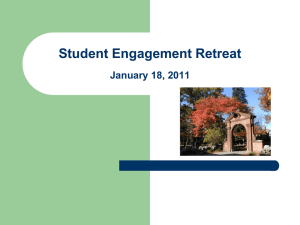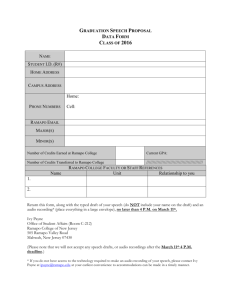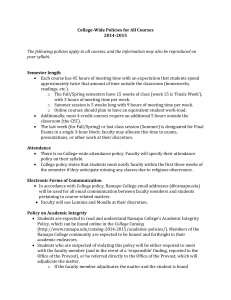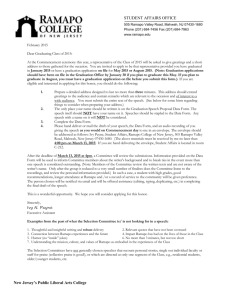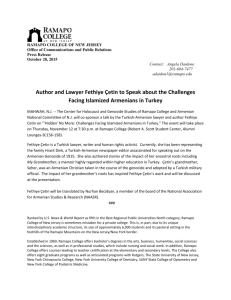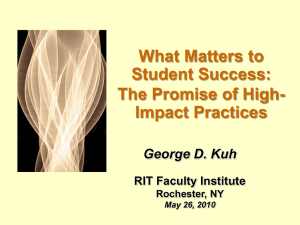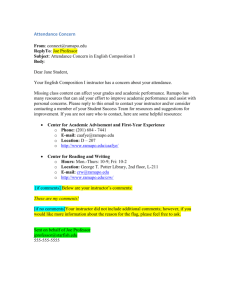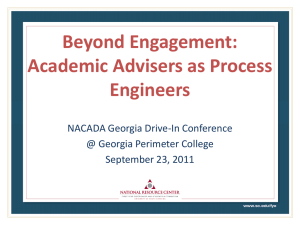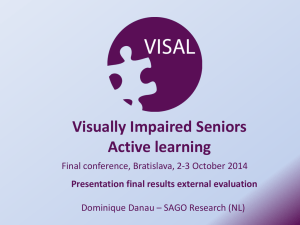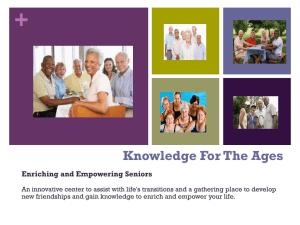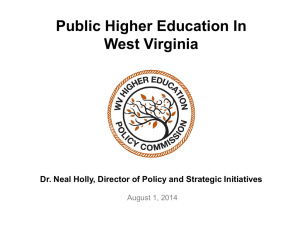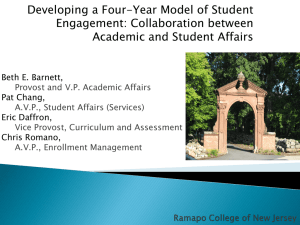What is Student Engagement?
advertisement
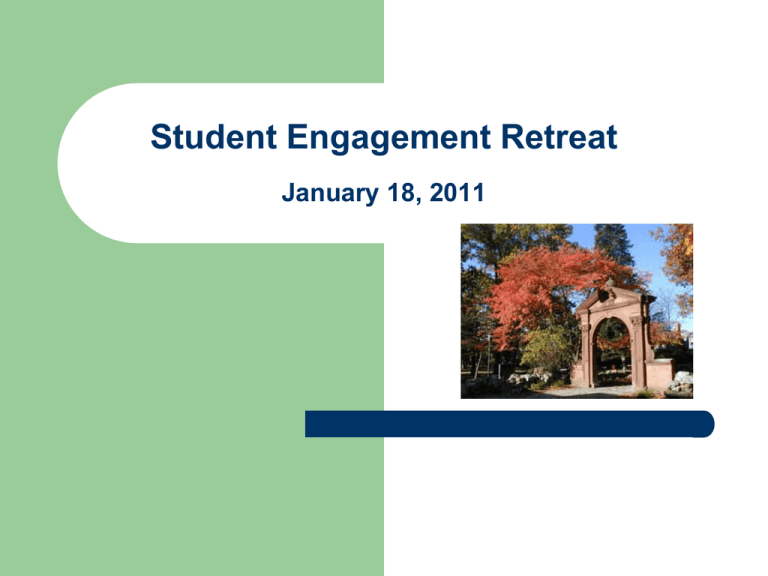
Student Engagement Retreat January 18, 2011 Background Why this retreat? (Context) Why this group? (Structure) What do we hope to accomplish ? (Purpose) Goals and Outcomes for the Retreat To define student engagement To review current data on student engagement at Ramapo To create a student engagement plan organized according to a college experience continuum. Goals and Outcomes for the Retreat To create a student engagement plan organized according to a college experience continuum. – – – – – Produce an inventory of current student engagement activities Determine which current activities achieve desired outcomes Identify new activities that Ramapo College should consider implementing Define or characterize stages of student engagement in the college experience Place activities, both current and proposed, in each of the defined stages Goals and Outcomes for the Retreat To define student engagement To review current data on student engagement at Ramapo To create a student engagement plan organized according to a college experience continuum. – – – – Determine which current activities achieve desired outcomes Identify new activities that Ramapo College should consider implementing Define or characterize stages of student engagement in the college experience Place activities, both current and proposed, in each of the defined stages To identify next steps What is Student Engagement? Student engagement represents the time and effort students devote to activities empirically linked to the intended outcomes of college and what institutions do to both provide these activities and induce students to participate in them (Kuh, 2009). Characteristics and Examples of Student Engagement Substantive interaction, in class and out of class, with peers, faculty, and staff - first year seminars, peer mentoring/education, facultystudent research, student attendance/presentation at conferences, living-learning communities, etc. Common experiences that deepen understanding of self and others – service learning, common readings, study abroad, etc. Opportunities to connect in class and out of class learning – campus job, co-curricular activities, club/organization/team involvement, etc. Positive Outcomes of Student Engagement Student engagement is generally considered to be among the better predictors of learning and personal development (Carini, Kuh, & Klein, 2006). “Educationally purposeful” practices produce the following student outcomes: – – – – – – Investing time and effort Interacting with faculty, staff, and peers about substantive matters Experiencing diversity Responding to more frequent feedback Reflecting and integrating learning Discovering relevance of learning through real-world experiences (Brownell & Swaner, 2010) What do we know about student engagement at Ramapo? National Survey of Student Engagement (NSSE) – Survey of students at four-year institutions – Self-reported data about participation in “educationally purposeful activities” – Indirect assessment of learning – Comparisons with peer groups – Benchmarks of Effective Educational Practice Benchmarks of Effective Educational Practice Level of Academic Challenge Active and Collaborative Learning Student-Faculty Interaction Supportive Campus Environment Enriching Educational Experiences Active and Collaborative Learning “Students learn more when they are intensely involved in their education... Collaborating with others in solving problems or mastering difficult material prepares students to deal with the messy, unscripted problems they will encounter daily during and after college.” (NSSE, 2010) About how often have you done each of the following? (1=never; 2=sometimes; 3=often; 4=very often) activity RCNJ freshmen seniors 2.81 3.16 asked questions in class made a class 2.42 presentation worked with classmates 2.40 outside of class discussed readings outside of class community-based project (part of course) COPLAC freshmen seniors 2.88 3.19 2.96 2.29 2.81 2.71 2.51 2.77 2.55 2.84 2.83 2.98 1.79 1.92 1.53 1.75 Supportive Campus Environment “Students perform better and are more satisfied at colleges that are committed to their success and cultivate positive working and social relations among different groups on campus.” (NSSE, 2010) What is the quality of your relationships with people on campus? (1=unfriendly and unsupportive; 7=friendly and supportive) people RCNJ freshmen seniors COPLAC freshmen seniors students 5.44 5.52 5.45 5.57 faculty 5.15 5.53 5.31 5.59 administrative personnel 4.53 4.35 4.78 4.64 Enriching Educational Experiences “Complementary learning opportunities inside and outside the classroom augment the academic program… Internships, community service, and senior capstone courses provide students with opportunities to synthesize, integrate, and apply their knowledge.” (NSSE, 2010) Which of the following have you done or do you plan to do … ? (0=not done; 1=done) activity RCNJ freshmen seniors COPLAC freshmen seniors Internship (and related activities) learning community research with faculty study abroad .05 .56 .06 .53 .07 .23 .15 .25 .07 .19 .04 .21 .01 .09 .02 .16 community service/ volunteer work .33 .59 .38 .61 How many hours do you spend [per] week doing each of the following? (2=1-5 hours; 3=6-10 hours) Activity RCNJ Freshmen co-curricular activities (organizations, publications, sororities, fraternities, SGA, sports) 2.46 COPLAC Seniors 2.15 Freshmen 2.37 Seniors 2.18 Institutional Outcomes and the Role of Strategic Enrollment Management Strategic Enrollment Management is “a comprehensive process designed to help an institution achieve and maintain optimum recruitment, retention and graduation rates of students where 'optimum' is defined within the academic context of the institution” (Dolence, 1993). Ramapo Context Enrollment plan aimed at attracting high achieving students SEM helps us map our outcomes versus schools with similar missions/selectivity Do our enrollment-related outcomes reflect the preparedness levels of the type of students we are admitting? Are we providing the experience to retain and ultimately graduate them? What do we know about Ramapo outcomes? 1st Year Retention Rates 88% 86% 84% 82% 80% 78% 76% 74% 72% RCNJ NJ Public State Colleges National What do we know about Ramapo outcomes in relation to similar schools? First Year Retention According To Selectivity 98% 96% 94% 92% 90% 88% 86% 84% RCNJ St. Mary's College of MD SUNY Geneseo TCNJ What do we know about Ramapo outcomes? Average 6 Year Graduation Rates 66.0% 64.0% 62.0% 60.0% 58.0% 56.0% 54.0% 52.0% 50.0% RCNJ NJ Public State Colleges National What do we know about Ramapo outcomes related to similar schools? Bottom Schools by Graduation Rate: Highly Competitive 70% 65% 60% 55% 50% Bennington College Stony Brook University The New School Ramapo College Northeastern University Source: AEI report Intersection of Enrollment Management and Student Engagement can improve these outcomes The single best predictor of student satisfaction with college is the degree to which students perceive the college environment to be supportive of their academic and social needs. (Pascarella/Terenzini, 2005) Student Engagement Plan How an institution deploys its resources and organizes the curriculum, other learning opportunities and support services leads to positive experiences and desired outcomes such as persistence, satisfaction, learning and graduation. (Kuh, 2001 and Pascarella/Terenzini, 2005) Small Group Activity (part 1) – Student Engagement Activity Inventory In your small groups please answer the following questions (goal 3): 1. What forms of student engagement does the College currently provide (outcome a)? a. b. c. Who is the target audience? How frequently does the activity occur (e.g., daily, yearly, etc.)? What data do we currently collect on the activity? Student Engagement Activity Inventory - Continued 2. Of those student engagement activities, which meet the desired outcomes, and how do we know (outcome b)? 3. What forms of student engagement does the College currently not provide but should consider implementing (outcome c)? Small Group Activity (part 2) – Student Engagement Plan In your small groups please answer the following questions (goal 3): 1. If we divided the college experience into stages along a continuum from first to final year, which activities would belong to each stage? To answer this question, take the activities identified this morning, both current and new, and cluster them where you think that they belong—first year, last year, or somewhere along the continuum between those two points. It is possible that a particular activity may belong to more than one stage. It is also possible that you may place an activity where it currently does not take place. Small Group Activity (part 2) – Student Engagement Plan FIRST YEAR FINAL YEAR Small Group Activity (part 2) – Student Engagement Plan In your small groups please answer the following questions (goal 3): 2. Why did you place the activities where you placed them on the continuum, and what commonalities does each cluster share? Small Group Activity (part 2) – Student Engagement Plan FIRST YEAR FINAL YEAR Commonalities of activities Commonalities of In the first year activities between the first and final year Commonalities of activities in the final year ORIENTATION COMMENCEMENT Four-Year Student Engagement Plan (Example) goal experiential international/ intercultural activity study abroad in-depth knowledge in the major engagement critical thinking F: attend fair M: explore options L: study abroad student organizations F: join club M: do project L: run for office academic advising F/M: explore majors and requirements FYS F: beginning skills capstone L: culminating project CEC F: focus on GE M: focus on major internship L: focus on career L: advanced skills Conclusion and Next Steps Review of purpose, goals and achievement Action Items Timeline Discussion References Brownell, J.E., Swaner, L.E. (2010). High-impact practices: Research on learning outcomes, completion, and quality. Washington, DC: Association of American Colleges and Universities. Brownell, J.E., Swaner, L.E. (2009). High-impact practices: Applying the learning outcomes literature to the development of successful campus programs. Peer Review, 11(2), 26. Carini, R., Kuh, G.D., & Klein, S.P. (2006). Student engagement and student learning: Testing the linkages. Research in Higher Education, 47(1). Kinzie, J.I., Kuh, G.D. (2004). Going deep: Learning from campuses that share responsibility for student success. About Campus. Kuh, G.D. (2009). What student affairs professionals need to know about student engagement. Journal of College Student Development, 50(6), 683. Pascarella, E.T & Terenzini, P.T (2005). How College Affects Students, Volume 2, A Third Decade of Research. San Francisco, CA: Jossey-Bass.
